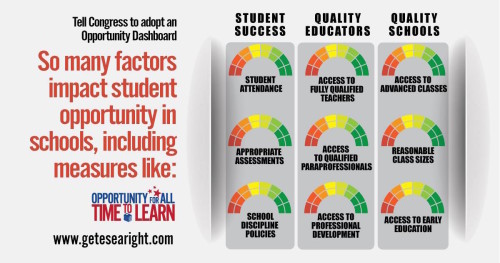Many public school educators may be surprised to learn that 535 members Congress and their staffs are deciding what teaching and learning will look like in the classroom over the next ten years. But that is exactly what is happening right now on Capitol Hill - the reauthorization, or rewriting, of the Elementary and Secondary Education Act - better known as No Child Left Behind.
The stakes couldn't be higher. What kind of education will we be able to deliver to our students for the next decade? Will public schools exit the era of “test and punish," "narrow curriculum," “drill and kill” and enter a period characterized more by “opportunity for all” and a “well-rounded education”?
That all hangs on how these five critical issues are addressed – and whether the voices of educators over the next few weeks are heard loud and clear.
 1. How Many Tests?
1. How Many Tests?
The number of federally-mandated standardized tests almost tripled over the past ten years. Harder to measure, however, is the intense stress felt by students and teachers from an accountability system based strictly on test scores. Whether Congress decides to preserve the one-size-fits-all annual federal testing structure or create a more flexible system for teachers and students is one of the most important questions being resolved right now on Capitol Hill. Less time spent on tests means more time to develop the types of assessments that will provide educators the most useful information to improve instruction and help students learn.
 2. More Time for Teaching and Learning
2. More Time for Teaching and Learning
The expression “teach to the test” didn't originate with NCLB, but the law practically branded it on every classroom door in the country. The average teacher now spends about 30 percent of her work time on testing-related tasks, including preparing students, proctoring, and reviewing results. The hours and days dedicated to test prep and test-taking have drained the joy out of teaching and learning, which, according to a recent NEA survey, has driven almost half of teachers to consider leaving the profession.
 Click on the image and spread the word: Let's hold states accountable for providing opportunity for all students.
Click on the image and spread the word: Let's hold states accountable for providing opportunity for all students.
3. Opportunity for All Students: Measuring the Important Things
In its relentless focus on measuring outcomes with test scores, NCLB failed to provide the resources to ensure that every student had the opportunity to learn and excel. As a result, achievement goals were never reached and teachers, students and schools were pilloried by everyone and anyone looking for a scapegoat. A new education law can set a better course by fostering greater transparency to parents and communities about the kinds of supports students truly need to learn and hold states accountable for providing the necessary resources and learning opportunities. This is why, when applying for ESEA funding, states should be mandated to report “opportunity dashboard” data. This includes student access to extracurricular activities, advanced placement courses, early education, school counselors and nurses and other indicators that can be used to attack inequity and the role of zip codes in determining quality of education.
 4. Remember Arts, Music and Social Studies?
4. Remember Arts, Music and Social Studies?
If Congress approves a bill that reduces the amount of, and high stakes attached to, standardized testing, time may be freed up to bring back subjects that have been sidelined during the NCLB era. Over the past decade, the presence of history, art, music, and physical education has diminished. Why? Because these subjects aren’t covered on standardized tests. High-poverty schools have been forced to narrow the curriculum much more drastically than wealthier schools—with worse consequences for low-income students. Regardless of socioeconomic background, every student should have access to a curriculum that fosters creativity and critical thinking—key skills that can't be developed through rote memorization and no. 2 pencils.
5. Smaller Class Size and Professional Development
ESEA reauthorization isn't all about the future of testing. Lawmakers are also debating what to do with Title II funds, which are dedicated to training and supporting teachers. Title II can also be used to hire more teachers and decrease class size. Congress is actually considering putting these programs on the chopping block by capping the use of Title II funds for reducing class size at 10 percent. During the 2013-14 school year, districts used 35 percent of their funds for this purpose. Unless this provision is protected, educator jobs will be lost and class sizes – especially in high-poverty schools– will increase, depriving countless students of valuable one-on-one instruction time.
Video: Congress is Talking About Testing
Take Action: Tell Congress to Get ESEA Right! Right now, the U.S. Senate is working on a reauthorization bill for the Elementary and Secondary Education Act. Ask your senators to give all students the opportunity to succeed






